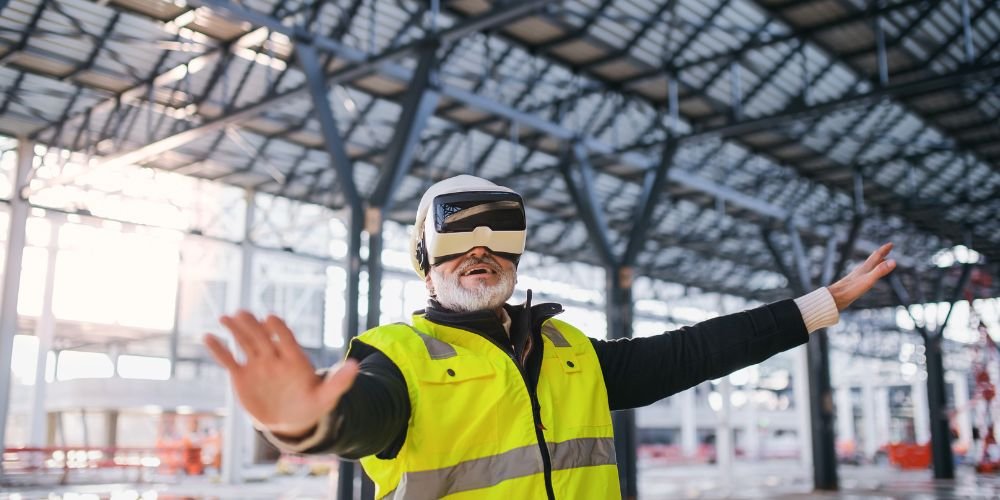Virtual Reality (VR) technology is revolutionizing the construction industry by offering immersive and interactive experiences that enhance design visualization, improve project coordination, and streamline decision-making processes. This article explores VR’s applications, benefits, and future trends in Construction, highlighting its potential to reshape how construction projects are planned, executed, and managed.
Understanding Virtual Reality (VR) in Construction
Virtual Reality (VR) in Construction involves the creation of realistic, computer-generated environments that simulate the physical world. These environments allow users to interact with and explore digital representations of construction projects. VR technologies enable architects, engineers, and stakeholders to visualize building designs, detect clashes, and evaluate construction sequences in a virtual environment before Construction begins.
Immersive Design Visualization
Virtual Reality (VR) in Construction provides immersive design visualization capabilities. Users can navigate through virtual building models and experience spaces as if they were physically present. Architects and designers can explore different design options, evaluate spatial relationships, and assess aesthetic qualities in real time, facilitating better-informed design decisions and enhancing client communication.
Clash Detection and Coordination
VR platforms facilitate clash detection and coordination efforts by integrating Building Information Modeling (BIM) data into immersive virtual environments. Project teams can identify clashes, conflicts, and coordination issues between building systems, such as mechanical, electrical, and plumbing (MEP) components, before Construction commences, reducing rework, minimizing errors, and optimizing construction efficiency.
Simulation-Based Training and Safety Planning
Virtual Reality (VR) in Construction enables simulation-based training and safety planning for construction workers. It allows them to undergo realistic and interactive training experiences in a virtual environment. Workers can practice tasks, procedures, and safety protocols in a risk-free setting, improving skill proficiency, reducing on-site accidents, and enhancing overall job site safety.
Advantages of Virtual Reality (VR) in Construction
Virtual Reality (VR) offers numerous advantages to construction projects, including enhanced visualization, improved collaboration, and increased efficiency throughout the project lifecycle.
Enhanced Visualization and Communication
Virtual Reality (VR) in Construction enhances visualization and communication by providing stakeholders with immersive and interactive experiences that facilitate better understanding and decision-making. Clients, contractors, and project teams can visualize building designs, identify design issues, and communicate design intent more effectively, improving project outcomes and client satisfaction.
Improved Collaboration and Coordination
VR platforms promote collaboration and coordination among project stakeholders by providing a centralized platform for reviewing and discussing project details in a virtual environment. Designers, engineers, and contractors can collaborate in real time, identify conflicts, and resolve issues collaboratively, resulting in smoother project workflows, reduced delays, and improved project coordination.
Increased Efficiency and Cost Savings
Virtual Reality (VR) in Construction streamlines construction processes, reduces rework, and improves project efficiency, resulting in cost savings throughout the project lifecycle. Virtual design reviews, clash detection, and simulation-based training enable early issue identification, minimizing costly errors and delays during Construction, ultimately reducing project costs and improving profitability.
Applications of Virtual Reality (VR) in Construction
Virtual Reality (VR) finds diverse applications across various stages of the construction project lifecycle, from design and planning to construction and facilities management.
Design and Visualization
In the design phase, Virtual Reality (VR) in Construction enables architects and designers to create immersive, three-dimensional representations of building designs. It allows stakeholders to visualize and experience spaces before Construction begins. VR visualization tools facilitate design reviews, client presentations, and design iterations, enabling better-informed design decisions and enhancing project outcomes.
Construction Planning and Coordination
During the construction phase, VR platforms support construction planning and coordination efforts by providing project teams with a virtual environment to review construction sequences, identify clashes, and coordinate project activities. VR coordination meetings, clash detection sessions, and site logistics planning enable proactive problem-solving and collaboration, leading to smoother construction workflows and reduced rework.
Training and Safety
In the training and safety domain, Virtual Reality (VR) in Construction offers realistic and interactive training experiences for construction workers, allowing them to practice tasks, procedures, and safety protocols in a virtual environment. VR-based safety training programs, equipment simulations, and hazard awareness exercises enhance worker competency, reduce on-site accidents, and improve overall job site safety.
Future Trends in Virtual Reality (VR) in Construction
The future of Virtual Reality (VR) in Construction holds exciting possibilities, with advancements in technology, software development, and industry adoption driving new opportunities for innovation and growth.
Integration with Augmented Reality (AR)
Integration with Augmented Reality (AR) technology is expected to enhance VR’s capabilities in Construction, enabling users to overlay digital information onto physical spaces in real-time. AR-enhanced VR applications offer context-aware visualization, on-site navigation, and interactive data overlays, improving on-site decision-making and collaboration among project teams.
Cloud-Based VR Collaboration Platforms
Cloud-based VR collaboration platforms are emerging as a key trend in Construction. These platforms enable remote stakeholders to participate in virtual meetings, design reviews, and coordination sessions from anywhere in the world. They offer scalability, accessibility, and real-time collaboration features, empowering global project teams to collaborate more effectively and efficiently.
AI-Powered Simulation and Analysis
AI-powered simulation and analysis capabilities are poised to enhance the realism and intelligence of VR environments in Construction. Machine learning algorithms and predictive analytics enable VR platforms to simulate complex construction scenarios, analyze project data, and generate actionable insights for project optimization, risk management, and decision support, driving greater efficiency and innovation in construction projects.
Conclusion
Virtual Reality (VR) technology transforms the construction industry by offering immersive visualization, enhanced collaboration, and improved efficiency throughout the project lifecycle. From design and planning to construction and facilities management, VR applications reshape how construction projects are conceived, executed, and delivered. As technology advances and industry adoption grows, VR is poised to become an indispensable tool for architects, engineers, contractors, and stakeholders, driving innovation, efficiency, and sustainability in construction projects worldwide.










